
(a)
Interpretation: An image representing various reactions is given. Various questions based on the given image are to be answered.
Concept introduction: According to the collision theory, for a reaction to take place the molecules must collide in proper orientation and must have minimum energy so that the effective collisions may occur.
To determine: The two images that describe the elementary steps which when combined depicts the destruction of Ozone by Chlorine.
(a)
Answer to Problem 13.12VP
Solution
The two images that describe the elementary steps which when combined depicts the destruction of Ozone by Chlorine are given by figure A and H.
Explanation of Solution
Explanation
The equation for the destruction of Ozone by Chlorine is given as,
The equation (1) is represented by the figure A as shown,

As three red balls correspond to
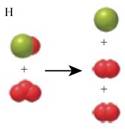
As three red balls correspond to
Conclusion
The two images that describe the elementary steps which when combined depicts the destruction of Ozone by Chlorine are given by figure A and H.
(b)
Interpretation: An image representing various reactions is given. Various questions based on the given image are to be answered.
Concept introduction: According to the collision theory, for a reaction to take place the molecules must collide in proper orientation and must have minimum energy so that the effective collisions may occur.
To determine: The image that represents the overall reaction for the Chlorine catalyzed destruction of Ozone.
(b)
Answer to Problem 13.12VP
Solution
The image that represents the overall reaction for the Chlorine catalyzed destruction of Ozone is given by figure E.
Explanation of Solution
Explanation
The equation for the destruction of Ozone by Chlorine is given as,
The overall reaction is given as,
This situation is represented by figure E as shown below,
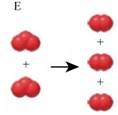
As three red balls combined in reactants correspond to
Conclusion
The image that represents the overall reaction for the Chlorine catalyzed destruction of Ozone is given by figure E.
(c)
Interpretation: An image representing various reactions is given. Various questions based on the given image are to be answered.
Concept introduction: According to the collision theory, for a reaction to take place the molecules must collide in proper orientation and must have minimum energy so that the effective collisions may occur.
To determine: The two images that describe the elementary steps which when combined describes the overall reaction in which
(c)
Answer to Problem 13.12VP
Solution
The two images that describe the elementary steps which when combined describe the overall reaction in which
Explanation of Solution
Explanation
The reaction involving
The equation (3) is represented by figure D as shown below,
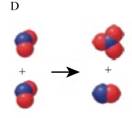
Here, a pair of combined red and blue balls corresponds to
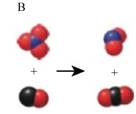
Here, three combined red balls along with one blue ball corresponds to
Conclusion
The two images that describe the elementary steps which when combined describe the overall reaction in which
(d)
Interpretation: An image representing various reactions is given. Various questions based on the given image are to be answered.
Concept introduction: According to the collision theory, for a reaction to take place the molecules must collide in proper orientation and must have minimum energy so that the effective collisions may occur.
To determine: The chemical equation for the reaction described in question (c).
(d)
Answer to Problem 13.12VP
Solution
The chemical equation for the reaction described in question (c) is,
Explanation of Solution
Explanation
The reaction involving
The chemical equation for the overall reaction is given by adding equation (3) and (4) as,
Conclusion
The chemical equation for the reaction described in question (c) is,
(e)
Interpretation: An image representing various reactions is given. Various questions based on the given image are to be answered.
Concept introduction: According to the collision theory, for a reaction to take place the molecules must collide in proper orientation and must have minimum energy so that the effective collisions may occur.
To determine: The image that shows photodecomposition of Chlorofluorocarbons.
(e)
Answer to Problem 13.12VP
Solution
The image that shows photodecomposition of Chlorofluorocarbons is given by figure G.
Explanation of Solution
Explanation
The decomposition of Chlorofluorocarbons is given as,
This equation is represented by figure G as shown below.

As four combined green and one black ball at left hand side corresponds to
Conclusion
The image that shows photodecomposition of Chlorofluorocarbons is given by figure G.
(f)
Interpretation: An image representing various reactions is given. Various questions based on the given image are to be answered.
Concept introduction: According to the collision theory, for a reaction to take place the molecules must collide in proper orientation and must have minimum energy so that the effective collisions may occur.
To determine: The decreasing order for the collision between Ozone and chlorine atoms.
(f)
Answer to Problem 13.12VP
Solution
The decreasing order for the collision between Ozone and chlorine atoms is
Explanation of Solution
Explanation
The absence of Ozone is represented by the blue cloud. The cloud is bigger in figure I, it means Ozone is most depleted in figure I and it corresponds to the maximum number of collisions between Ozone and Chlorine atoms as shown below,
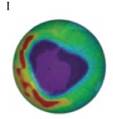
Then figure F shows the less depletion of Ozone in comparison to figure I as shown below,
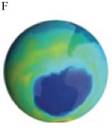
The least depletion of Ozone is shown in figure C as shown below,
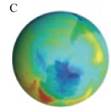
Therefore, the decreasing number of collisions is given by
Conclusion
The decreasing order for the collision between Ozone and chlorine atoms is
Want to see more full solutions like this?
Chapter 13 Solutions
CHEMISTRY W/WRKBK AND SMARTWORK (LL)
- Draw the products of a reaction of the following alkyle chloride, shown below in the 3D ball and stick model with NaSCH3. Ignore inorganic byproducts. In the figure, a gray ball indicates a carbon atom a white ball indicates a hydrogen atom anda agreen ball indicated a chlorine atomarrow_forwardDraw the most stable cations formed in the mass spectrometer by a deavage of the following compound Draw the most stable cations formed in the mass spectrometer by a cleavage of the following compound онarrow_forwardCurved arrows are used to illustrate the flow of electrons. Using the provided starting anand product sytucutrs, draw the curved electron-pusing arrows for the following reaction or mechanistic steps. Be sure to account for all bond-breaking and bind-making stepsarrow_forward
- Draw the major elimination and substitution products formed in this reavtion. Use a dash or wedge bond to indicatr the stereochemistry of substituents on assymetric centers, wheere applicable. Ignore any inorganic byproducts.arrow_forwardDraw the two possible products produced in this E2 elimination. Ignore any inorganic byproductsarrow_forwardDraw the major products of this SN1 reaction. Ignore any inorganic byproducts.arrow_forward
- Draw the major elimination and substitution products formed in this reaction. Use a dash or wedge bond to indicate the stereochemistry of substituents on asymmetric centers, wehre applicable. Ignore and inorganic byproducts.arrow_forwardCurved arrows are used to illustrate the flow of electrons. Using the provided starting and product structures, draw the curved electron-pushing arrows for the following reaction or mechanistic step(s). Be sure to account for all bond-breaking and bond-making steps. Drawing Arrows THE Problem 33 of 35 N. C:0 Na + Submit Drag To Pan +arrow_forwardDraw the product of the E2 reaction shown below. Include the correct stereochemistry. Ignore and inorganic byproducts.arrow_forward
- Draw the major producrs of this SN1 reaction. Ignore any inorganic byproducts. Use a dash or wedge bond to indicate the sereochemistry of substituents on asymmetric centers where appllicable.arrow_forward5) Oxaloacetic Acid is an important intermediate in the biosynthesis of citric acid. Synthesize oxaloacetic acid using a mixed Claisen Condensation reaction with two different esters and a sodium ethoxide base. Give your answer as a scheme Hint 1: Your final acid product is producing using a decarboxylation reaction. Hint 2: Look up the structure of oxalic acid. HO all OH oxaloacetic acidarrow_forward20. The Brusselator. This hypothetical system was first proposed by a group work- ing in Brussels [see Prigogine and Lefever (1968)] in connection with spatially nonuniform chemical patterns. Because certain steps involve trimolecular reac tions, it is not a model of any real chemical system but rather a prototype that has been studied extensively. The reaction steps are A-X. B+X-Y+D. 2X+ Y-3X, X-E. 305 It is assumed that concentrations of A, B, D, and E are kept artificially con stant so that only X and Y vary with time. (a) Show that if all rate constants are chosen appropriately, the equations de scribing a Brusselator are: dt A-(B+ 1)x + x²y, dy =Bx-x²y. diarrow_forward
 ChemistryChemistryISBN:9781305957404Author:Steven S. Zumdahl, Susan A. Zumdahl, Donald J. DeCostePublisher:Cengage Learning
ChemistryChemistryISBN:9781305957404Author:Steven S. Zumdahl, Susan A. Zumdahl, Donald J. DeCostePublisher:Cengage Learning ChemistryChemistryISBN:9781259911156Author:Raymond Chang Dr., Jason Overby ProfessorPublisher:McGraw-Hill Education
ChemistryChemistryISBN:9781259911156Author:Raymond Chang Dr., Jason Overby ProfessorPublisher:McGraw-Hill Education Principles of Instrumental AnalysisChemistryISBN:9781305577213Author:Douglas A. Skoog, F. James Holler, Stanley R. CrouchPublisher:Cengage Learning
Principles of Instrumental AnalysisChemistryISBN:9781305577213Author:Douglas A. Skoog, F. James Holler, Stanley R. CrouchPublisher:Cengage Learning Organic ChemistryChemistryISBN:9780078021558Author:Janice Gorzynski Smith Dr.Publisher:McGraw-Hill Education
Organic ChemistryChemistryISBN:9780078021558Author:Janice Gorzynski Smith Dr.Publisher:McGraw-Hill Education Chemistry: Principles and ReactionsChemistryISBN:9781305079373Author:William L. Masterton, Cecile N. HurleyPublisher:Cengage Learning
Chemistry: Principles and ReactionsChemistryISBN:9781305079373Author:William L. Masterton, Cecile N. HurleyPublisher:Cengage Learning Elementary Principles of Chemical Processes, Bind...ChemistryISBN:9781118431221Author:Richard M. Felder, Ronald W. Rousseau, Lisa G. BullardPublisher:WILEY
Elementary Principles of Chemical Processes, Bind...ChemistryISBN:9781118431221Author:Richard M. Felder, Ronald W. Rousseau, Lisa G. BullardPublisher:WILEY





